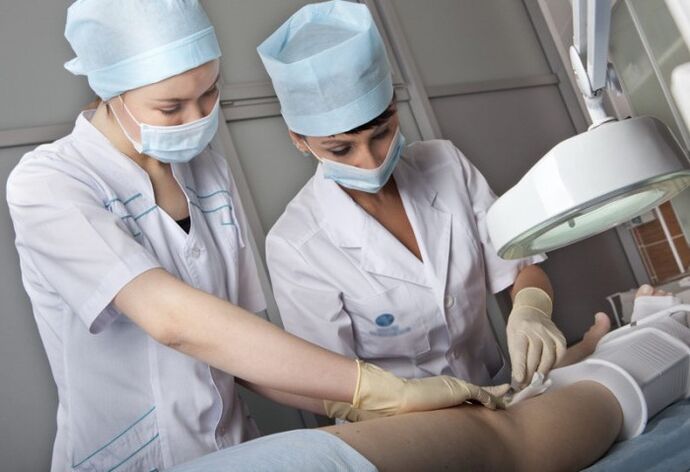
When is vein surgery performed?
- If the disease has become widespread and progressive;
- If the saphenous vein becomes very large;
- If the flow of blood in the blood vessels is disturbed, this is why the legs constantly hurt, quickly tire and become heavy;
- If the skin is nutritionally affected;
- If you have a non-healing trophic ulcer on your leg;
- If thrombophlebitis worsens.
How to prepare for surgery
- Take a shower in the morning;
- Shave your legs to prevent excess hair from interfering with your doctor's efforts to treat varicose veins;
- Arrive at the hospital a little earlier than your appointment to prepare for your upcoming surgery.
If, after lower extremity surgery, the patient requires hospitalization for rehabilitation, the doctor must also be systematically informed of the medications he is taking.
Types of surgery for varicose veins
- In phlebectomy, only those veins affected by varicose veins are removed. The diseased vein is removed through a small incision in the leg;
- To remove the great saphenous vein and its tributaries, dissection is required. This varicose vein surgery is performed through an incision in the groin fold. Ligate the post-operative vein and place a bandage on the leg;
- During hardening, diseased blood vessels are filled with a special substance that glues them together. What appears is not diseased veins, but scar tissue, which then disappears without a trace with the help of special preparations;
- Treatment of varicose veins in the lower limbs is performed using a laser beam that penetrates the veins through a special puncture. With laser treatment, the veins are welded together, which dissolve and disappear after a period of time. Patient reviews indicate that this surgical intervention is very effective, resulting in no recurrence of the disease.

recovery after surgery
- Get adequate rest;
- Go outside for a walk;
- Carry out physical exercise taking into account the permissible load determined individually for each patient;
- follow dietary habits;
- Wrap the surgical site on the leg tightly with an elastic bandage;
- Wear specialized knitted compression underwear;
- Do not lift heavy objects;
- Watch your weight.
How to eat during recovery
- Drink apple cider vinegar twice a day. Two tablespoons should be diluted with half a cup of water;
- Among vegetables, cabbage, green peppers, tomatoes, carrots and herbs are considered useful. You can prepare salads with them, dressing them with vegetable oil or lemon juice;
- In terms of fruits, eating gooseberries, black currants, oranges, strawberries, apples, and lemons are beneficial;
- To fill the body with useful substances, cereal porridge can be prepared;
- To replenish your veins with vitamin E, add vegetable oil to your dishes - olive, pumpkin or sunflower oil;
- In order to keep the venous system full of elastin, it is important to include seafood in the diet. It is recommended to eat kelp every day. If income permits, make salads with mussels, crab, shrimp, oysters, and squid;
- To maintain blood vessel health, it is recommended to eat a few walnut kernels every day.
Possible complications and consequences after surgery
- Bruises form and disappear on their own within a month. They rarely stay on the skin for more than two months;
- Sometimes, the skin begins to thicken at the site of the puncture or incision. Within a month, the seal will disappear on its own;
- If the skin incision touches a nerve ending, the patient may experience pain in the area. It also takes some time for the wound to heal completely;
- Swelling may occur if the leg is placed under heavy load after surgery. Therefore, it is recommended to avoid strenuous physical labor during the first few days after venous surgery.
Precaution
- First, slowly bend and straighten your knees. Make circular motions with your feet to increase the speed of venous blood flow;
- When sleeping, make sure your legs are slightly higher than your torso;
- After a few days, he began to take the initiative to sit up in bed;
- An elastic bandage is placed on the operated leg, and walking and light physical therapy exercises begin. It is recommended to wear an elastic bandage for three months after surgery.
Contraindications for varicose vein surgery
It is important that surgery to remove varicose veins is performed by an experienced phlebologist. Therefore, in order not to risk your health, you need to carefully read the reviews of different doctors. Only after a thorough analysis of the information collected about the doctor can you go to the chosen specialist and trust him to solve your problem.
What to do if you have contraindications to surgery
- With the help of a compression garment, dilated blood vessels can remain normal. To choose the right pressure, you need to consult a doctor;
- You can use yogurt and mugwort decoction to make a lotion for sore areas on your legs. Compresses made from hops infusion, alcoholic tincture of Kalanchoe leaf, honey cabbage, or raw potatoes are also useful;
- The early stages of varicose veins are treated with leech therapy. The treatment uses leech saliva, which thins the blood and helps it circulate better through the veins. However, small scars are sometimes left on the skin after this treatment;
- To treat this disease, blue clay is also used to prepare lotions, masks or baths;
- Varicose veins in the legs can be treated with special ointments, creams, patches, gels or tablets after consulting a doctor.























